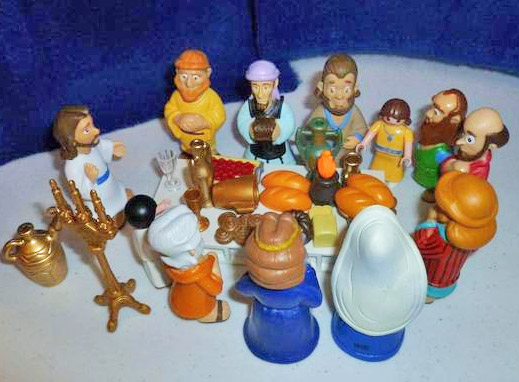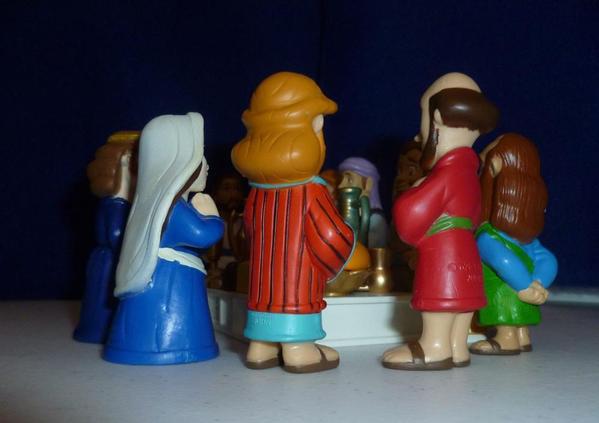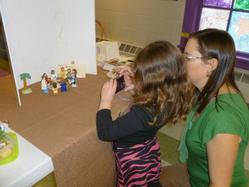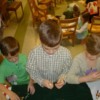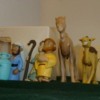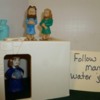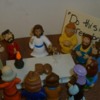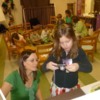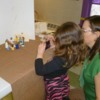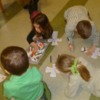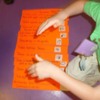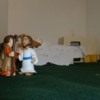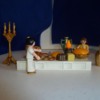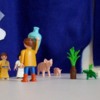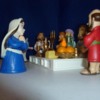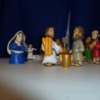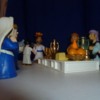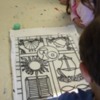Here is a complete set of lessons, with a Bible Background for…
The Last Supper
Summary of all workshops in this Rotation:
- Art: Children will create a “stained glass” window depicting some symbols of communion.
- Games/Bible Skills: Children will play several “remembering games” to learn about symbols of Communion. Older children will compare the gospel accounts of the story.
- Cooking: Children will prepare several foods that are part of the traditional Passover meal.
- Drama: Children will create and photograph a three-dimensional diorama of scenes from the Last Supper, using action figures and small props. The photos will be made into a slide show.
- Video: Children will view The Easter Story, from the Greatest Adventure Stories from the Bible series.
Scripture Reference:
Matthew 26:17-30, Mark 14:12-25, Luke 22:7-20 (Using the NIV Adventure Bible)
The Picture Bible: “Secretly in an Upper Room” and “The Lord’s Supper” page 641-645.
Memory Verse:
“This is my body given for you; do this in remembrance of me.” Luke 22:19 (may shorten for younger children to Do this is in remembrance of me.)
Theme:
Jesus gave us a way to remember him through the sacrament of Communion.
Lesson Objectives:
- Children will locate the story in the Bible.
- Children will retell the events of the Lord’s Supper in their own words.
- Children will recognize that Jesus and his disciples were Jewish and celebrated the Jewish feast of Passover.
- Children will explore the different components of the Passover celebration.
- Children will recognize the connection between the Jewish Passover celebration and the Christian sacrament of Communion.
- Children will become familiar with the terms: sacrament, covenant, communion.
- Children will recognize that Jesus wants us to participate in Communion as a way to remember Him.
- Children will identify the Lord’s Supper as one of the key events of Holy Week.
- Children will memorize Luke 22:19.
Music:
- “Books of the Old Testament,” Books of the Bible, Custom CD, Troy and Genie Nilsson.“Books of the New Testament,” Books of the Bible, Custom CD, Troy and Genie Nilsson.
- "Books of the New Testament," Books of the Bible, Custom CD, Troy and Genie Nilsson.“Books of the New Testament,” Books of the Bible, Custom CD, Troy and Genie Nilsson.
- "Mighty to Save," Laura Story, Great God Who Saves, 2008.
- "You are my King - Amazing Love," Phillips, Craig and Dean, Greatest Hits, Sparrow Records, 2007.
- "This is Love," Terry Butler, Change My Heart O God, Vineyard Music, 1999.
- “Remembrance (Communion Song),” Matt Redmon, We Shall Not Be Shaken, 2010.
- “In Remembrance of Me, “Very Best of Cheri Keaggy, Sparrow Records, 2006.
- “Paid in Full,” Yancy, Rock N Happy Heart, 2008.
Extra Resources: Journey to the Cross, Helen Haidle, Zonderkidz, 2001.
Background Information
The Passover
Jesus and his disciples were devout Jews who celebrated all of the Jewish customs and feasts. One of the most important Jewish festivals was the festival of Passover. Each year on the Passover, Jewish families celebrated a feast to remember God’s mighty acts of mercy and deliverance from slavery in Egypt. The Passover festival lasted for eight days – one day for Passover followed by the Feast of Unleavened Bread for seven additional days. On the first night of Passover, Jewish families eat a special meal called a Seder (SAY-dur) and retell the Exodus story.
Jews traveled to Jerusalem to celebrate this festival at the Temple as instructed by law (see Leviticus 23:29-30). The population of Jerusalem, normally about 150,000 – 200,000 would swell by an additional 80,000-100,000 people! For Jesus and his disciples this meant a walk of about 75 miles from Galilee. The walk was arduous, but this particular trip was difficult for Jesus for a different reason. By going to Jerusalem, Jesus knew He would encounter direct conflict from the people who were threatened by His teachings. He knew that His death was near. Jesus knew that this would be his last Passover with his friends.
In the synoptic gospels (Matthew, Mark and Luke – synoptic means “seen alongside” – these gospels tell the stories of Jesus from the perspectives of different individuals), Jesus sends his disciples ahead to make preparations for the Passover meal. The Last Supper is described as the Passover meal. In John’s gospel, the meal takes place on the eve before the Passover, thus placing Jesus’ death (the true Passover lamb) at the very time the Passover lambs were being sacrificed. Some scholars note that there is an allowance for Passover to be celebrated on different dates (either the 14th or the 15th day of the month of Nisan), however, most believe that the Last Supper was actually a Passover meal.
Passover Meal and New Meaning:
The Passover Seder consists of several very specific items symbolizing parts of the Exodus story:
Unleavened bread: Leaven is simply yeast or baking powder, the substance that makes bread rise. It is found in bread, cookies, crackers, etc. In the Bible, leaven is symbolic of sin. Unleavened bread is used as a reminder that the Jewish people left Egypt in a hurry, without enough time to let their bread rise. Matzoh (unleavened bread) is available today in grocery stores. Jesus referred to himself as the Bread of Life. Christians can see matzoh as a symbol of Jesus himself. It is free from leaven (sin), it has stripes on it where it was grilled (symbolizing the stripes on Jesus’ back from the whip), and it is pierced with small holes (symbolizing the piercing of Jesus’ hands/wrists, feet and side).
White Linen: White is a symbol of righteousness in the Bible. The Passover table is covered with a white tablecloth, trimmed with white candles and the father wears a white robe called a kittel and a white crown. White dishes and napkins are sometimes used in Jewish homes today.
Four cups of wine: A cup of wine is filled four times to remind the Jews of God’s four promises to them: God would take them out of Egypt, release them from slavery, redeem them and make them a nation. Wine is also used to remind them of the ten plagues which the Egyptians suffered. A cup is also set at the table for Elijah, the prophet whose return the Bible says will announce the coming of the Messiah and the bringing of peace for the entire world.
Salt Water: Salt water represents the tears of the Hebrew slaves as they worked for Pharaoh, tears for the babies who were killed by Pharaoh’s decree, tears for the hard years wandering in the desert, and tears for the lives that were taken because of people’s faith in God.
Parsley or Romaine lettuce: The green vegetables and herbs symbolize the hope of springtime and the hope of the Hebrew people when they left Egypt. The greens are dipped in the salt water to taste the difficult life of slavery.
Bitter Herbs: Horseradish represents the oppression of the people in Egypt.
Haroset (Charoseth): This is a mixture of apples, nuts and wine (grape juice). It represents the mortar and bricks that the Hebrew slaves made for Pharaoh. Bitter herbs are dipped into this. The combination of bitter and sweet reminds us of the difficult life of the slaves and their hope for freedom.
Lamb bones: A perfect lamb was sacrificed/killed and the blood painted over the door of the Hebrew homes in Egypt. The blood was a sign to the Angel of Death (the tenth and final plague) to “pass over” that house, because it was protected by the Lord. Christians see an obvious symbol here for Jesus, referred to in the Scriptures as the “Lamb of God,” who by dying on the cross “takes away the sins of the world” and saves us just as God used the blood of the lamb on the doorposts in Egypt long ago to save the Hebrew babies.
Hard boiled/Roasted Egg: Jewish scholars are unsure of the purpose of the egg on the Seder plate. It is not eaten because it is so hard. It may symbolize the hardness of Pharaoh’s heart. It may symbolize mourning. It may be a symbol of new life. It may be a carryover from Babylonian pagan worshipers who worshiped the egg as a symbol of fertility. Their goddess, Ishtar, is most likely the source of the name “Easter.”
A family/community celebration:
Passover has always been a family and community celebration. New Testament families often banded together to travel and celebrate within identifiable groups. Jesus sat together with his twelve disciples for the Passover meal. Jesus served as head of the family group and thus assumed the role of the father of the family, saying the special blessings and conducting the traditional Seder meal. But Jesus surprised His friends with a special message on that evening.
Jesus, the master teacher, used two of the familiar items of Passover, the bread and wine, in a way that radically altered their meaning. By describing the bread as “ my body” and the cup as “my blood of the new covenant which is poured out for many,” He introduced a new understanding to the old and familiar customs. God commanded the Israelites to celebrate the Passover to remember Him and His saving grace. Jesus commanded the disciples to celebrate Communion to remember Him and His saving grace of the new covenant.
The apostles understood covenants -- God had established a recurring cycle of covenants with the Hebrew people in the past, continually calling people into relationship with Him. (A covenant is a sacred promise, a bond between God and His people.) God promised to love and care for the people. The people promised to obey God. When a covenant was broken, as it was inevitably, the relationship between God and God’s people was broken. To restore relationship, an elaborate system of sacrifices was developed.
In the Old Testament, God’s covenants with individuals were sealed by an act of animal sacrifice. These sacrifices always involved the shedding of blood and the destruction of the body. Old Testament covenants had to be renewed by repeated sacrifices; the Hebrew people were required to offer a certain number of sacrifices throughout the year in order to symbolize their continued willingness to be in covenant with God. If a covenant was broken, a new one had to be established with a new series of sacrifices.
The new covenant indicates a new relationship with God where Jesus’ death -- his shedding of blood -- takes away the sins of all who believe in Him and fulfills all of the earlier covenant promises. Jesus’ blood is sprinkled on the doorposts of the believer’s heart, just as the blood of the first Passover lambs was sprinkled on the doorposts of the Hebrews’ homes in Egypt. With Jesus’ death and resurrection, humankind is finally restored to right relationship with God, once and for all. The final sacrifice required for humanity has been offered, a perfect one that requires no repetition. Jesus lived and died to bring us into this new relationship with God. His sacrificial death ushered in the new covenant. “The Passover Feast was always a feast which commemorated the saving action of God; and now this saving action is to be demonstrated in a new and unique way.“ (Barclay 54) Jesus turned an ancient memorial of deliverance into a new memorial of what he had done and was about to do.
Jesus’ words and their meaning:
The three synoptic gospels differ slightly in their descriptions of the meal. But basically there are four components to His message:
- the bread is the body of Jesus and it is for them (us).
- the cup represents the covenant blood of the new covenant (a new relationship between God and humanity, made possibly at the cost of Jesus’ life and death)
- instruction to repeat this meal to remember what Jesus has said and done
- hope for the future – an affirmation of the full coming of the Kingdom of God, and a time when we will all eat together in unity at Christ’s table.
The Christian church has struggled through the centuries to understand just how Christ is present in the sacrament of Communion. United Methodists affirm the reality of Christ’s presence, although we do not claim to be able to explain it fully. “We do not embrace the medieval doctrine of transubstantiation,* though we do believe that the elements are essential tangible means through which God works. We understand the divine presence in temporal and relational terms. In the Holy Meal of the church, the past, present, and future of the living Christ come together by the power of the Holy Spirit so that we may receive and embody Jesus Christ as God’s saving gift for the whole world.” (This Holy Mystery)
*The Roman Catholic understanding is called transubstantiation. Roman Catholics believe that Christ is present in the wine and the bread. While the outward appearance of the elements does not change, the internal reality does. They are actually transformed into the body and blood of Christ. Consubstantiation is often associated with the teachings of Martin Luther. Luther taught that the body and blood of Christ are present "in, with, and under the forms" of bread and wine. Lutherans today believe that the bread and wine are present in a natural manner, while Christ’s true body and blood are present in a supernatural manner. They believe Christ is present alongside the substance of the bread and wine, which remain present.
William Barclay summarizes the meaning of Jesus’ words in a simple and understandable way: “This bread stands for my body which is going to be for you. This cup stands for the new relationship between man and God made possible by the death which I am going to die.” But perhaps the most important words are the instructions, “Do this in remembrance of me.” First and foremost we celebrate the sacrament of Communion to remember Jesus and what He has done for us.
Early Church History:
The Lord’s Supper quickly became an established part of the early church. The first churches met in homes and the Lord’s Supper was celebrated along with a meal, as was the first Lord’s Supper. The meal was a way to satisfy physical hunger as well as spiritual hunger. This practice grew into what became known as “love feasts.” Over time the practice of love feasts fell out of favor among many denominations because of their potential for abuses – for example drunkenness, gluttony and snobbish exclusion of others. Some denominations still practice love feasts today continuing the tradition of fellowship and sacrament as did the earliest Christians.
The Last Supper/Lord’s Supper Today:
Christians celebrate the Lord’s Supper as a sacrament (United Methodists and most Protestants recognize two sacraments: baptism and communion. Some denominations also recognize foot-washing as a sacrament. Roman Catholics recognize additional sacraments, including marriage, confirmation and last rites) The word sacrament comes from the Latin word sacramentum. Its original meaning was a sacred pledge or promise of absolute and sacrificial loyalty (originally among Roman officers). The early church father, Augustine, defined sacraments as “signs connected with divine things.” A sacrament is a common thing that reveals a truth beyond itself, bringing new meaning.
A sacrament is by nature a mystery. The New Testament understanding of mystery does not mean complicated, complex or hard to understand. Rather it is simple, but obscure to the outsider, while being meaningful to an insider. This explains the reasoning of some contemporary worship services (so-called “seeker” services) which do not offer Communion during their services (some churches offer Communion before or after the service for those who wish to partake), believing non-believers would not understand the sacrament. John Wesley, on the other hand, would probably disagree. Wesley believed that communion was a means of grace, a practice by which God can draw us to faith, convicting our hearts and moving us to conversion. Thus United Methodists practice “Open Communion” inviting “all who earnestly repent of their sin and seek to live in peace with one another.” All are welcome to partake including children. United Methodists believe the choice of whether or not to receive Communion is between the individual and God.
The Last Supper is recreated each time we celebrate Holy Communion. The sacrament is known by several names: Last Supper (a misnomer actually because of the forward thinking nature of the meal), the Lord’s Supper, Holy Communion and the Eucharist. Each name reveals something special about the different facets of the sacrament. The Lord’s Supper reminds us that Jesus is the one who initiated the sacrament and He does the inviting to the table. Communion comes from the Greek word Koinonia and means fellowship with an emphasis on community. The Eucharist comes from the Greek word for thanks (eucharisteo) and reminds us that giving thanks to God for His mercies and grace is part of the meal.
By understanding the meaning behind the Jewish Passover, we gain a better understanding of the meaning of Jesus’ actions. The “bread of life” and the “blood of the covenant” sustain our faith and remind us of the presence of God in our lives each time we partake of Communion.
Throughout the Passover meal, Jesus tried to explain to His friends that His time on earth was coming to an end. The disciples did not understand. Jesus knew that they would face difficult challenges ahead and He gave them a way to come together to support one another and to remember Him. We continue this today.
For Younger Children:
The symbols of the Last Supper are abstract and may be difficult for children to understand. The idea of “body and blood of Christ” and “given for you” are probably beyond the comprehension level of most early elementary children. For these children, focus on the remembering aspect of Communion. Jesus asked us to set aside this special act as a way to remember Him and what He said and did. It may help to explain to the children that Jesus did not mean that the bread and wine were literally his body and blood. These were symbols that help us understand the Jesus is with us in a special way.
Sources: Information adapted from New Invitation and Invitation Bible Studies, Bible Zone #3, Cornerstones Publishing, Zola Levitt - The Miracle of Passover, A Passover Seder for Christian Kids by Neil MacQueen, https://www.rotation.org/topic/295011598215932326; Jesus Christ: Holy Week and Crucifixion, Thomas a Langford and C. Clifton Black II, Graded Press, 1985; The Lord’s Supper, William Barclay, Westminster John Knox Press, 2001; Journey to the Cross, Helen Haidle, Zonderkidz, 2001; This Holy Mystery: A United Methodist Understanding of Holy Communion Copyright © 2003, 2004 The General Board of Discipleship of The United Methodist Church; United Methodists and Communion: Some Questions and Answers, The United Methodist Publishing House, 2001; Handbook of Bible Festivals, Galen Peterson, Standard Publishing, 1997; Touch the Water, Taste the Bread - Exploring the Sacraments with Children; A Christian Passover Seder Meal by Cindy and Catherine Fournier.
A lesson set written by Jaymie Derden for State Street UMC – G.R.E.A.T. Adventure program, 2013
Bristol, VA
A representative of Rotation.org reformatted this post to improve readability.

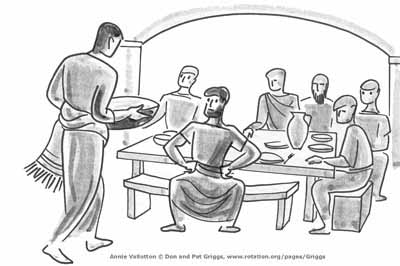 This forum is part of Rotation.org's
This forum is part of Rotation.org's 